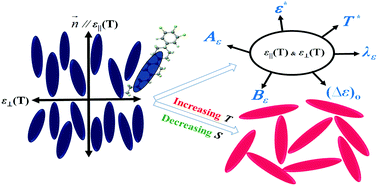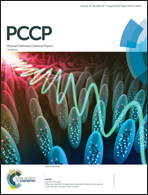Physical model for temperature-dependent dielectric properties of anisotropic nematic liquid crystals†
Abstract
We derived a new analytic physical model for describing the temperature-dependent dielectric permittivities εe(T) and εo(T) in anisotropic mesophase molecules of nematic liquid crystals (NLCs). These temperature-dependent dielectric properties of NLCs could be explained by a six-parameter dielectric permittivity model, where the analytic dielectric permittivity curves of εe(T), εo(T), and Δε(T) from the model using the six parameters ε*, Aε, Bε, (Δε)o, λε, and T* showed excellent agreement with experimental data. The six-parameter dielectric permittivity model was compared to the conventional four-parameter refractive index model. To systematically investigate the temperature-dependent properties of the refractive indices (ne(T) and no(T)) and dielectric permittivities according to the molecular structure of the NLCs, four similar types of fluorinated phenyl bicyclohexane NLCs were selected. Using the presented models, the temperature-dependent behaviour of these four fluorinated NLCs was discussed, according to the molecular length of the alkyl chains and the positions of the fluorine substituents. In particular, two fitting equations for the temperature-dependent properties of threshold voltage and splay elastic LC constant could also be developed using the physical coefficients extracted from the six-parameter dielectric permittivity model, and these equations coincided well with experimental results.



 Please wait while we load your content...
Please wait while we load your content...